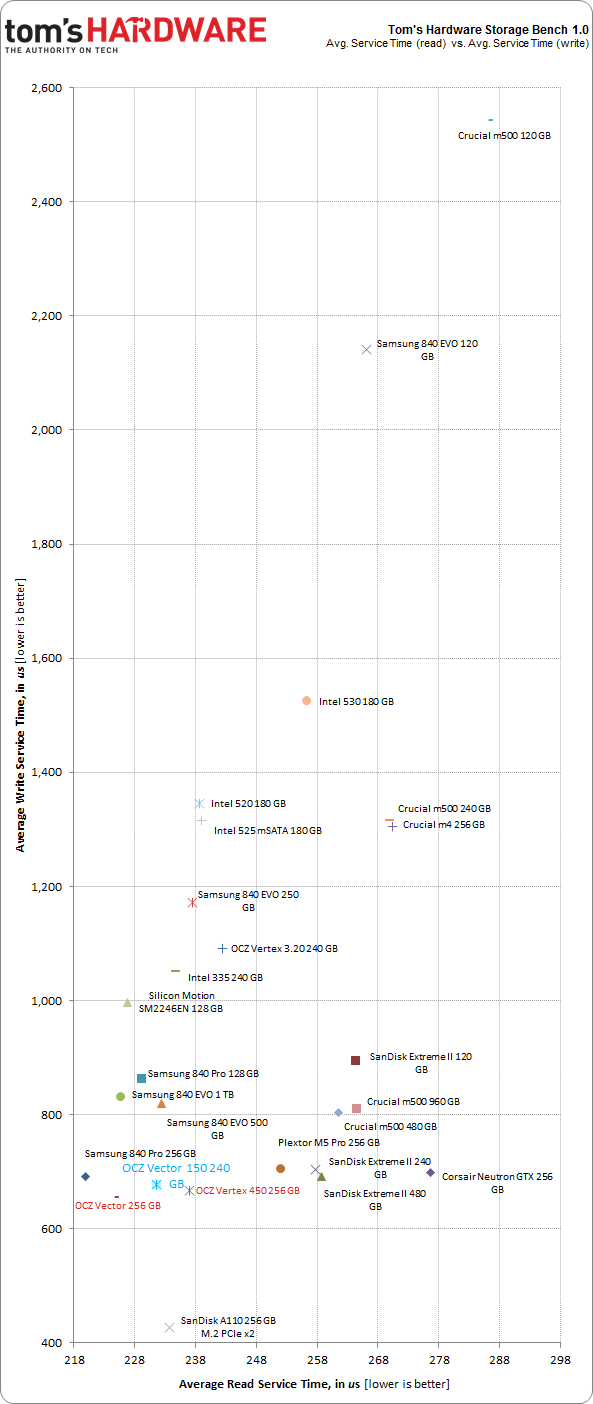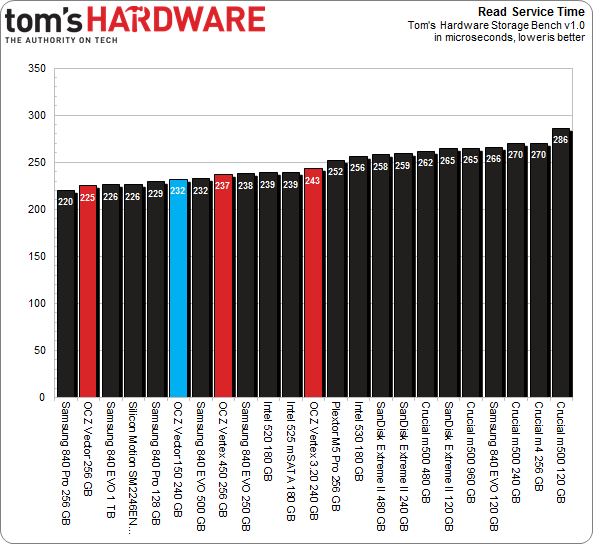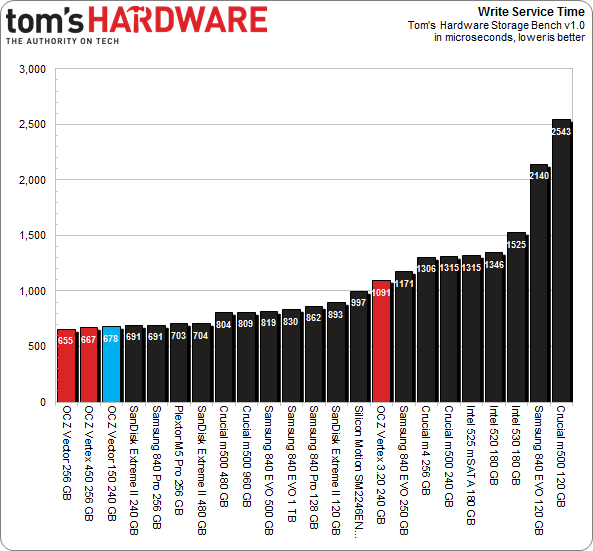OCZ Vector 150 SSD Review: A New Flagship With 19 nm Flash
OCZ is re-launching its flagship consumer SSD as the Vector 150. Armed with 19 nm Toggle-mode flash and new encryption functionality, this new drive is purported to be the pinnacle of of enthusiast-class solid-state storage. Does it live up to the hype?
Results: Tom's Hardware Storage Bench, Continued
Service Times
Beyond the average data rate reported on the previous page, there's even more information we can collect from Tom's Hardware's Storage Bench. For instance, mean (average) service times show what responsiveness is like on an average I/O during the trace.
It would be difficult to graph the 10+ million I/Os that make up our test, so looking at the average time to service an I/O makes more sense. For a more nuanced idea of what's transpiring during the trace, we plot mean service times for reads against writes. That way, drives with better latency show up closer to the origin; lower numbers are better.
Write latency is simply the total time it takes an input or output operation to be issued by the host operating system, travel to the storage subsystem, commit to the storage device, and have the drive acknowledge the operation. Read latency is similar. The operating system asks the storage device for data stored in a certain location, the SSD reads that information, and then it's sent to the host. Modern computers are fast and SSDs are zippy, but there's still a significant amount of latency involved in a storage transaction.
OCZ's refreshed Vector drive falls behind even the Vertex 450 in terms of write latency, though that margin is imperceptible, and only something we pick up due to the righteously large nature of this chart. Remember, the further south and west a drive appears, the better.
And yes, once again, the Vector 150 falls right between the Vector and Vertex 450. Not highlighted, but also of interest, OCZ's Vertex 3.20 240 GB appears just below the Vertex 450 in our trace's read service times, but far behind in writes. Both of those drives employ 20 nm ONFi NAND, though the Vertex 450 gets the advantage of a different processor and OCZ's performance mode/storage mode technology.
I'm highlighting all of the OCZ drives, but it's easy to imagine where the drives fall without the entirety of this chart. The Vertex 3.20 shows up right in the middle of the field, a few thousandths of a second per I/O behind the Vertex 450, which in turn is a few thousandths behind the Vertex 150. In second place, just behind Samsung's magnum opus, is the original Vector.
Mean write service times are more varied, resulting in more separation in the chart at the top of this page. It's telling that the podium is dominated by OCZ, with the Vector and Vertex 450 followed by its new Vector 150. The gold, silver, and bronze contenders aren't distinguished by much, but a difference does exist.
Get Tom's Hardware's best news and in-depth reviews, straight to your inbox.
Current page: Results: Tom's Hardware Storage Bench, Continued
Prev Page Results: Tom's Hardware Storage Bench Next Page Results: PCMark 7 And PCMark Vantage-
jimmysmitty Reply11918040 said:time to upgrade from vertex 4 to 150
I just hope the quality increased. Only because at my last job we had used Vertex 3s for all of our work stations and they one by one started having random issues, from not being detected to wiping the partitions.
I like OCZ because they help lower the price of SSDs but there has to be quality behind the price as well. -
Sakkura Some of the numbers in the bottom diagram on page 4 seem to be off. Look at the Intel 520 180GB for example; the random write bar is longer than the random read bar, but the actual IOPS numbers are the other way around.Reply -
Sakkura Reply
My impression is that OCZ was hit hard by the Sandforce issues, partially as a result of being an early adopter. Their newer drives seem to be reliable.11918340 said:11918040 said:time to upgrade from vertex 4 to 150
I just hope the quality increased. Only because at my last job we had used Vertex 3s for all of our work stations and they one by one started having random issues, from not being detected to wiping the partitions.
I like OCZ because they help lower the price of SSDs but there has to be quality behind the price as well. -
cryan Reply11918441 said:Some of the numbers in the bottom diagram on page 4 seem to be off. Look at the Intel 520 180GB for example; the random write bar is longer than the random read bar, but the actual IOPS numbers are the other way around.
Awesome catch! The 520 seems to have the right bar length, but the label from the Intel 510. I'll sort that out, but that's a genuine not-my-fault problem. One of the very few. I can blame Excel 2013 with confidence, but kudos for the eagle eye.
The random write bar is correct though; the SandForce-based 520, 525, and Intel 530 each pull down more random write IOps than read with incompressible data.
Regards,
CR -
Amdlova I got two SSD vertex 4 128gb on my computer 3770k and on my girlfriend 3470 I never get an single error on this SSD. raid 0 or normal configs. run solid!Reply -
ssdpro Reply11918455 said:My impression is that OCZ was hit hard by the Sandforce issues, partially as a result of being an early adopter. Their newer drives seem to be reliable.
Early on yes, but the 2nd gen SF drives really are pretty darn stable now. OCZ has had solid top tier releases since the Vertex 4. I own Vertex 4 and Vector, will probably get a 150. Hands down the worst thing they ever did was try budget/value offerings like the Petrol. I don't think there is any reason for fanboism, I own Samsung and OCZ drives and all work happily together.


